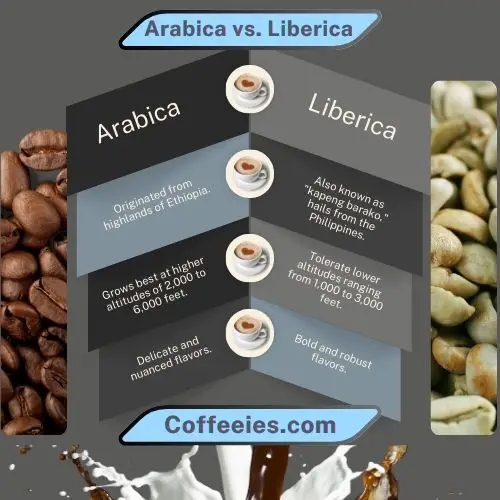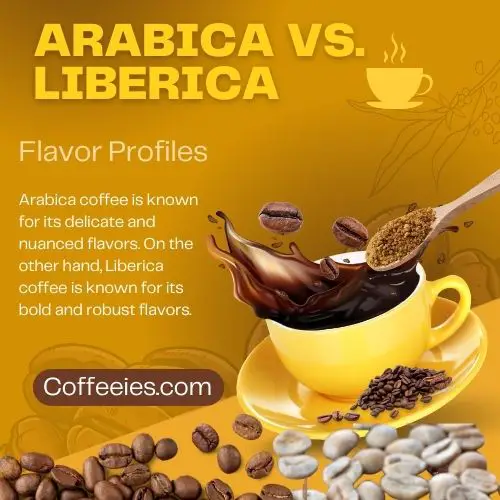Did you know that over 60% of the world’s coffee production comes from Arabica and Liberica beans?
If you’re a coffee lover, understanding the differences between these two varieties is essential.
From their origins to flavor profiles, and caffeine content to brewing methods, this article will dive into the fascinating world of Arabica vs. Liberica.
So grab your favorite mug, sit back, and get ready to explore the unique characteristics of these two beloved coffee beans.
Summary
- Arabica originated from Ethiopia and spread throughout the Arabian Peninsula, while Liberica hails from the Philippines.
- Arabica thrives in cooler temperatures and higher altitudes, while Liberica prefers warmer climates and lower altitudes.
- Arabica offers a wide range of taste notes with bright acidity, while Liberica has bold and robust flavors with lower acidity.
- Arabica coffee has a delicate and complex fragrance, while Liberica coffee has a robust and intense aroma.

Jump to a specific section
- 1 12 Key Differences: Arabica vs. Liberica
- 2 A Detailed Explanation of the Table
- 2.1 1. Origin of Arabica and Liberica:
- 2.2 2. Growing Conditions for Arabica and Liberica:
- 2.3 3. Flavor Profiles:
- 2.4 4. Aroma Comparison:
- 2.5 5. Caffeine Content:
- 2.6 6. Acidity Levels:
- 2.7 7. Body and Mouthfeel:
- 2.8 8. Price Differences:
- 2.9 9. Popular Uses of Arabica and Liberica Beans:
- 2.10 10. Availability and Accessibility:
- 2.11 11. Roasting Techniques for Arabica and Liberica:
- 2.12 12. Brewing Methods for Arabica and Liberica Beans:
- 3 Frequently Asked Questions
- 3.1 1. Are There Any Health Benefits Associated With Arabica and Liberica Beans?
- 3.2 2. Can Arabica and Liberica Beans Be Blended to Create a Unique Flavor Profile?
- 3.3 3. Do Arabica and Liberica Beans Require Different Processing Methods After Harvesting?
- 3.4 4. Are There Any Environmental Concerns Associated With Growing Arabica and Liberica Beans?
- 3.5 5. Can Arabica and Liberica Beans Be Used to Make Decaffeinated Coffee?
- 4 Conclusion
- 5 Resources Used For Research
12 Key Differences: Arabica vs. Liberica

| Serial No. | Aspect | Arabica | Liberica |
|---|---|---|---|
| 1 | Origin | Ethiopia, Arabian Peninsula | Philippines |
| 2 | Growing Conditions | Cooler temperatures, higher altitudes | Warmer climates, lower altitudes |
| 3 | Flavor Profile | Wide range, bright acidity | Bold, robust, lower acidity |
| 4 | Aroma | Delicate, complex | Robust, intense |
| 5 | Caffeine Content | 1.2% – 1.5% | 1.0% – 1.3% |
| 6 | Acidity Levels | Higher acidity | Lower acidity |
| 7 | Body and Mouthfeel | Light to medium, smooth | Heavy, full-bodied |
| 8 | Price | More expensive | Relatively lower |
| 9 | Popular Uses | Specialty drinks, blends | Traditional coffee preparations |
| 10 | Availability | Widely available | Less common |
| 11 | Roasting Techniques | Medium to medium-dark roast | Dark roast |
| 12 | Brewing Methods | French Press, Pour Over, Espresso | Pour Over, Cold Brew |
A Detailed Explanation of the Table
1. Origin of Arabica and Liberica:
Now, let’s delve into the origin of Arabica and Liberica, so you can better understand their historical roots.
Arabica, the most widely consumed coffee species, is believed to have originated from the highlands of Ethiopia. It was later cultivated in Yemen and spread throughout the Arabian Peninsula.
On the other hand, Liberica, also known as “kapeng barako,” hails from the Philippines. Introduced during the Spanish colonial period, Liberica thrived in the country’s fertile soil and warm climate.
While Arabica has a long and established history, Liberica’s story is more localized. Nevertheless, both species have played significant roles in the world of coffee.
Now that you know their origin, let’s explore the growing conditions for Arabica and Liberica.
2. Growing Conditions for Arabica and Liberica:
Perfect Daily Grind YouTube Channel
To successfully grow Arabica and Liberica coffee, you’ll need to understand the specific growing conditions for each species. Here are the key factors to consider:
- Climate: Arabica thrives in cooler temperatures ranging from 60 to 70°F (15 to 24°C), while Liberica prefers warmer climates between 75 to 85°F (24 to 29°C).
- Altitude: Arabica grows best at higher altitudes of 2,000 to 6,000 feet (600 to 1,800 meters), whereas Liberica can tolerate lower altitudes ranging from 1,000 to 3,000 feet (300 to 900 meters).
- Sunlight: Arabica prefers shaded environments with filtered sunlight, while Liberica can withstand direct sunlight.
- Soil: Arabica requires well-drained, acidic soil with a pH level of 6 to 6.5, while Liberica is more adaptable and can tolerate a wider range of soil conditions.
Understanding these specific growing conditions will help you cultivate healthy and productive Arabica and Liberica coffee plants.
3. Flavor Profiles:
Get ready to explore the distinct flavor profiles of Arabica and Liberica coffee.
Arabica coffee is known for its delicate and nuanced flavors. It offers a wide range of taste notes, including fruity, floral, and even chocolatey undertones.
The acidity in Arabica coffee tends to be bright and vibrant, giving it a lively and refreshing taste.
On the other hand, Liberica coffee is known for its bold and robust flavors. It often has a woody or smoky taste, with hints of nuttiness and even a touch of spice.

The flavor of Liberica coffee is strong and intense, making it a preferred choice for those who enjoy a more robust cup of coffee.
Now, let’s move on to the aroma comparison: Arabica vs. Liberica.
4. Aroma Comparison:
Take a moment to compare the aromatic profiles of Arabica and Liberica coffee. When it comes to aroma, Arabica and Liberica offer distinct characteristics that can elevate your coffee experience.
Here are four key aroma differences to consider:
- Arabica coffee is known for its delicate and complex fragrance. It often exhibits floral notes such as jasmine, and lavender, or even citrusy hints like bergamot or lemon zest.
- Liberica coffee, on the other hand, has a more robust and intense aroma. It is often described as having a woody or smoky scent, with hints of dark chocolate or even tobacco.
- Arabica coffee tends to have a sweeter aroma profile, with notes of caramel or honey. This lends a pleasant, inviting scent to the brew.
- Liberica coffee has a bolder and earthier aroma, with hints of spices like cloves or nutmeg. It can provide a more robust and invigorating olfactory experience.
Whether you prefer the delicate and sweet aromas of Arabica or the bold and intense scents of Liberica, both offer distinct aromatic profiles that add to the overall enjoyment of your coffee.
5. Caffeine Content:
If you’re looking for a coffee with a higher caffeine content, Arabica is the way to go compared to Liberica.
Arabica beans generally contain about 1.2% to 1.5% caffeine, while Liberica beans have a lower caffeine content, ranging from 1.0% to 1.3%.
This means that Arabica coffee has a slightly higher caffeine concentration than Liberica coffee.
The difference may not be significant for most people, as the caffeine levels in both types of coffee are still relatively similar.
However, if you’re someone who enjoys the energizing effects of caffeine or needs that extra kick in the morning, Arabica coffee might be the better choice for you.
Just keep in mind that the caffeine content can also vary depending on factors such as the roast level and brewing method used.
6. Acidity Levels:
Do you know which type of coffee, Arabica or Liberica, has higher acidity levels? When it comes to acidity, Arabica coffee beans generally have higher levels compared to Liberica.
Here are a few key points to consider:
- Arabica beans are known for their bright and lively acidity, which adds a pleasant tanginess to the coffee.
- Liberica beans, on the other hand, have a lower acidity level, resulting in a smoother and milder taste profile.
- The acidity in Arabica coffee is often described as complex, with fruity or citrusy notes, making it popular among coffee connoisseurs.
- Liberica coffee, with its lower acidity, appeals to those who prefer a more mellow and less acidic flavor.
7. Body and Mouthfeel:
Regarding the body and mouthfeel, Arabica coffee beans have a lighter and smoother texture compared to Liberica.
Arabica beans are known for their delicate and nuanced flavors, with a body that is often described as medium to light. They have a pleasant acidity and a clean finish that leaves a subtle aftertaste.
On the other hand, Liberica beans have a heavier and more robust body, with flavors that can be described as bold and intense.
The mouthfeel of Liberica coffee is often described as full-bodied and even syrupy.
Here is a comparison table showcasing the differences in body and mouthfeel between Arabica and Liberica:
| Arabica | Liberica | |
|---|---|---|
| Body | Light to Medium | Heavy |
| Mouthfeel | Smooth | Full-bodied |
Despite their contrasting profiles, both Arabica and Liberica have unique qualities that appeal to different coffee enthusiasts.
8. Price Differences:
Typically, you’ll find that Arabica coffee beans are more expensive compared to Liberica. The price difference can be attributed to various factors, including:
- Demand: Arabica beans are highly sought after for their superior flavor and aroma, leading to higher demand and subsequently driving up the price.
- Growing Conditions: Arabica is a delicate plant that requires specific altitudes, climates, and soil conditions to thrive. This makes it more challenging and costly to cultivate, resulting in a higher price tag.
- Yield: Liberica plants produce larger beans and higher yields compared to Arabica. This increased supply helps keep the price of Liberica beans relatively lower.
- Market Availability: Arabica beans are more readily available in the market compared to Liberica, which is less common. This scarcity contributes to the higher price of Arabica.
Understanding the price differences between Arabica and Liberica beans can help you make informed decisions about your coffee choices. Now, let’s delve into the popular uses of Arabica and Liberica beans.
9. Popular Uses of Arabica and Liberica Beans:
If you’re a coffee lover, you’ll be interested to know the popular uses of Arabica and Liberica beans.
Arabica beans are widely used for making specialty coffee drinks such as espresso, cappuccino, and latte. Due to their mild and smooth flavor, Arabica beans are often preferred for black coffee as well.
They are also commonly used in coffee blends to enhance the overall taste and aroma.
On the other hand, Liberica beans are often used in traditional coffee preparations, such as Turkish coffee and Vietnamese coffee.
The robust taste of Liberica beans makes them ideal for those who enjoy a strong and intense cup of coffee.
10. Availability and Accessibility:
If you’re wondering about the availability and accessibility of Arabica and Liberica beans, you’ll be pleased to know that both varieties can be found in various coffee shops and online retailers.
Here are a few ways you can easily get your hands on these beans:
- Local coffee shops: Many coffee shops carry both Arabica and Liberica beans, allowing you to enjoy their unique flavors in the comfort of your own home.
- Online retailers: With just a few clicks, you can order Arabica and Liberica beans from online retailers and have them delivered right to your doorstep.
- Specialty coffee stores: These stores often have a wide range of coffee beans, including Arabica and Liberica, for you to choose from.
- Coffee subscriptions: Some companies offer coffee subscriptions that deliver freshly roasted Arabica and Liberica beans directly to your mailbox regularly, ensuring you never run out of your favorite brew.
With these options, you can easily access and enjoy the distinct flavors of Arabica and Liberica coffee beans.
11. Roasting Techniques for Arabica and Liberica:
To achieve the best flavors and aromas, you should experiment with different roasting techniques for both Arabica and Liberica beans. Roasting plays a crucial role in determining the taste profile of coffee.
For Arabica beans, a medium to medium-dark roast is commonly preferred to bring out its delicate flavors and acidity. This roast level allows the bean’s natural sweetness and fruity notes to shine.
On the other hand, Liberica beans can withstand a darker roast. Their robust and bold characteristics are enhanced by a dark roast, which brings out deep flavors and a hint of smokiness.
However, it’s important to note that personal preferences vary, so don’t be afraid to experiment with different roast levels and techniques to find the perfect cup of coffee that suits your taste.
12. Brewing Methods for Arabica and Liberica Beans:
For the best results, you should consider using different brewing methods for both Arabica and Liberica beans, as each method can accentuate the unique characteristics of each coffee bean.
Here are some brewing methods to try:
- French Press: This method is perfect for Arabica beans as it brings out their rich and full-bodied flavors.
- Pour Over: Liberica beans have a bold and intense flavor profile, and the pour-over method allows you to extract all the unique flavors and aromas.
- Espresso: Arabica beans are known for their bright acidity and complex flavors, making them ideal for espresso shots.
- Cold Brew: Liberica beans’ natural sweetness and low acidity are enhanced when brewed using the cold brew method, resulting in a smooth and refreshing cup of coffee.
Frequently Asked Questions
1. Are There Any Health Benefits Associated With Arabica and Liberica Beans?
You’ll be thrilled to know that both Arabica and Liberica beans offer numerous health benefits. From boosting brain function to reducing the risk of chronic diseases, these beans are a fantastic addition to your diet.
2. Can Arabica and Liberica Beans Be Blended to Create a Unique Flavor Profile?
Yes, you can blend Arabica and Liberica beans to create a unique flavor profile. Mixing these two types of beans can result in a delicious and distinctive taste that coffee enthusiasts may enjoy.
3. Do Arabica and Liberica Beans Require Different Processing Methods After Harvesting?
You might think that Arabica and Liberica beans require the same processing methods after harvesting. However, they have distinct characteristics that call for different approaches.
4. Are There Any Environmental Concerns Associated With Growing Arabica and Liberica Beans?
When growing Arabica and Liberica beans, there are environmental concerns you should be aware of. These include the impact of deforestation, water usage, and pesticide use. It’s important to consider sustainable practices for both types of beans.
5. Can Arabica and Liberica Beans Be Used to Make Decaffeinated Coffee?
Yes, both Arabica and Liberica beans can be used to make decaffeinated coffee. The decaffeination process removes most of the caffeine content, allowing you to enjoy your favorite coffee without the jitters.
Conclusion
In the world of coffee, Arabica and Liberica beans each bring their unique characteristics and flavors to the table.
Arabica is like a gentle breeze on a sunny morning with its delicate aroma and smooth taste. Liberica, on the other hand, with its bold and robust profile, is like a fiery sunset on a tropical island.
Whether you prefer the subtlety of Arabica or the boldness of Liberica, there’s a coffee bean for every palate. Explore the world of coffee and let your taste buds embark on a flavorful journey.
Resources Used For Research
- Physical Properties of Liberica Coffee (Coffea liberica) Berries and Beans
- A Comparative Study of the Volatile Constituents of Southeast Asian Coffea arabica, Coffea liberica and Coffea Robusta Green Beans and their Antioxidant Activities
- ECU: Comparison of liberica and arabica coffee
- Evaluation of the effect of the roasting process on the energy transition and the crystalline structures of Arabica, Robusta, and Liberica coffee from Jambi Indonesia
- The re-emergence of Liberica coffee as a major crop plant

Thanks for sharing. I read many of your blog posts, cool, your blog is very good.